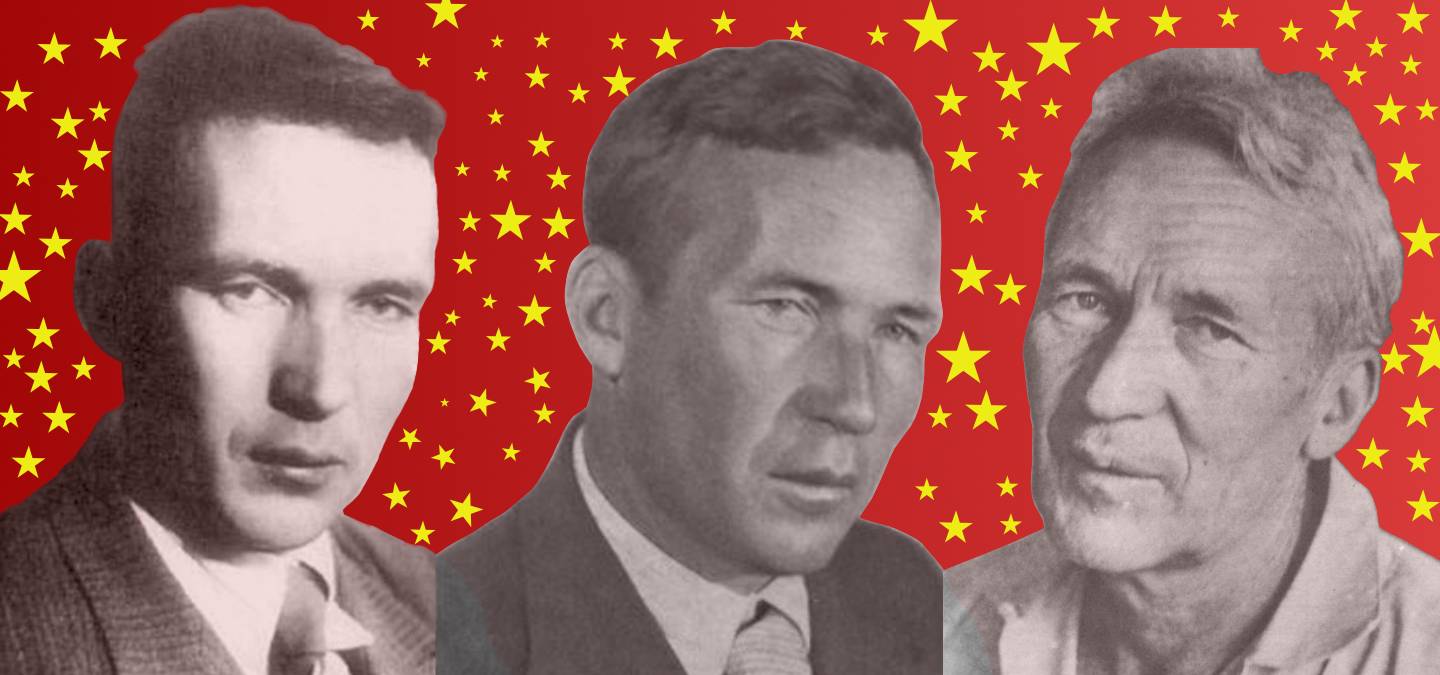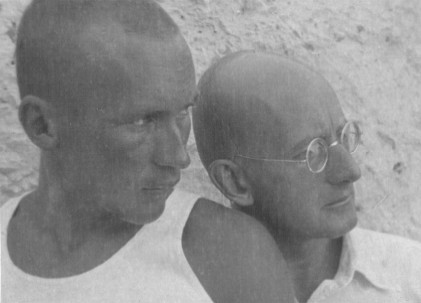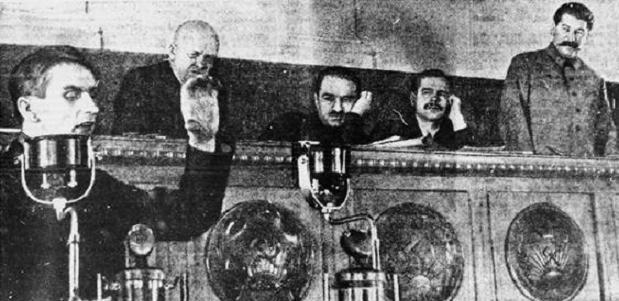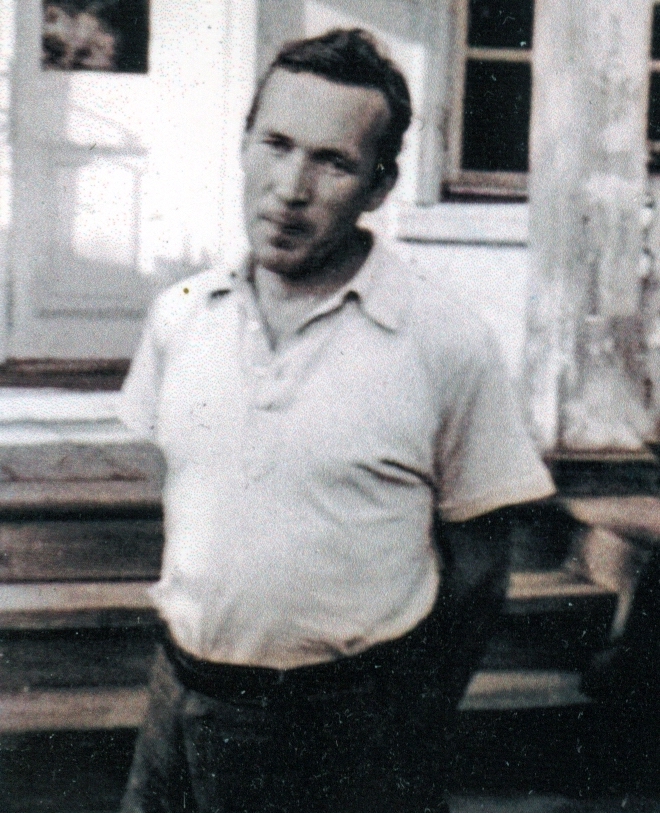Andrei Kolmogorov is one of the greatest mathematicians of the 20th century. He revolutionized every subject he approached from a surprisingly original perspective with astonishing insight and imagination...
Retrouvez la version française de cet article ici !
Андрей Николаевич Колмогоров (Andreï Nikolaevich Kolmogorov) is a Soviet mathematician, one of the greatest mathematicians of the twentieth century. Also one of the brightest, deepest and most original minds the world has ever known. Whether in probability, statistics, functional analysis, spectral analysis, geometry, approximation theory, intuitionist logic, algebraic topology, genetics, ecology, dynamic systems, turbulence, classical mechanics, information theory, algorithmic complexity, education... he revolutionized each topic with surprisingly new and totally original perspectives. His ideas were always far-reaching and appeared in very short articles: only a few pages of astonishing depth, insight and imagination — and its bibliography includes more than 500 publications. He was admired by his fellow mathematicians around the world for over 60 years and gave the impression that he could prove any theorem he wanted.
He is (probably) best known for his work on probability theory and particularly for his Grundbegriffe der Wahrscheinlichkeitsrechnung (« Foundations of the theory of probability »), a modest 60-page monograph published in 1933. By reconstructing rigorously the whole theory of probability, his little book has totally revolutionized the field, both scientifically and culturally.
But let us begin at the beginning. A. N. Kolmogorov was born in 1903 in Tambov, a small town in Russia, by pure chance: his single mother was returning from Crimea to his grandfather's house in Tunoshna, near Yaroslavl; she died when he was born. The name Kolmogorov comes from this maternal grandfather Yakov Stepanovich Kolmogorov, a prosperous nobleman, and not from his father Nikolai Matveyevich Kataev, a farmer in exile for his participation in the Russian revolution, who disappeared during the civil war in 1919.
Kolmogorov was raised in Tunoshna by his mother's sister, his aunt Vera Yakovlena, whom he considered to be his real mother.
It has been said that Kolmogorov published his first literary and mathematical essays while he was pupil in Tunoshna; that later, as a teenager, he invented perpetual motion machines; and that after temporarily interrupting his studies to become a train conductor and write a treatise on Newtonian mechanics, he devoted himself to metallurgy in addition to mathematics, while also drafting a thesis on Russian history.
He entered Moscow State University in 1920 and excelled mainly in mathematics. Still as an undergraduate, he obtained world-class results in Fourier analysis: while until then one was only able to build Fourier series which converge almost everywhere, against all expectations, at only 19 years old, Kolmogorov finds a periodic integrable function whose Fourier series diverge almost everywhere! Better yet, three years later, he obtains a Fourier series that diverges... everywhere. The proof of this difficult result is published as a simple note at the Paris Academy of Sciences.
Graduated from Moscow University in 1925, he began his thesis with Nikolai Luzin. That year he published no less than 8 articles, notably on intuitionist logic — which shows that he had always been interested in the foundations of mathematics. Brouwer had founded intuitionism in total opposition to classical formalism by refusing “reductio ad absurdum” and the actual infinity; intuitionist logic was, therefore, considered weaker than classical logic. Again against all odds, Kolmogorov formalizes intuitionist logic as an extension of classical logic, so that any “finitary” proposition that can be classically proved also admits an intuitionist proof... all of this in two pages!
Also in 1925, he begins to publish some beautiful theorems on probability. It refines the famous Tchebyshev inequality $\mathbb{P}(|S_n|> \varepsilon) \leq \sigma^2 / \varepsilon^2$ (for a sum $S_n = X_1+\cdots + X_n$ of independent zero-mean variables, with variance $\sigma^2$) by proving the Kolmogorov inequality $$\mathbb{P}(\sup_{k\leq n} |S_k| > \varepsilon)\leq \sigma^2/\varepsilon^2,$$ which allows him to prove (with Khintchine) a famous “three series theorem” which gives a necessary and sufficient condition on the convergence of three deterministic series so that the random series $\sum_n X_n$ (where the $X_n$ no longer necessarily have a zero mean) is almost surely convergent. These results will inspire Doob for his theory of martingales. By the time of his doctorate achievement in 1929, Kolmogorov had written eighteen articles on logic, analysis and probability, including a strong law of large numbers and a law of the iterated logarithm.
In the summer of 1929 he made friends with the mathematician Pavel Alexandrov during a boat trip on the Volga, through the Caucasus Mountains, to Lake Sevan in Armenia. Kolmogorov was then working on continuous-time Markov processes which he approached from an original point of view: instead of studying trajectories, he determined the differential equations satisfied by the densities of transition probabilities, premises of the modern theory of diffusion processes. Kolmogorov and Alexandrov make another long trip in the summer of 1931, to Berlin, Göttingen, Munich and Paris, where Kolmogorov begins in-depth discussions with Paul Lévy. They then spend a month at the seaside with Maurice Fréchet. Kolmogorov became a professor at Moscow University the same year.
It was in 1933 that his Grundbegriffe was published in German. This manual on the Foundations of the theory of probability made a major contribution to Hilbert's sixth problem (1900): ``axiomatize physics'', more precisely:
treat in the same manner as geometry, by means of axioms, those physical sciences in which already today mathematics plays an important part; in the first rank are the theory of probabilities [and mechanics].
Inspired by Borel, many mathematicians had sketched various axiomatizations of probability, but Kolmogorov definitively settles the question: His natural axiomatics makes it possible at last to define conditional expectation and stochastic processes rigorously, and has prevailed until now.
On this occasion he states his famous all-or-none law (or zero-one law) which establishes that any asymptotic tail event can only be of probability $0$ or $1$: there is no “ half measure ”. This result has profoundly changed the probabilists' viewpoint. From it Kolmogorov deduces the optimal version of the strong law of large numbers for independent and identically distributed variables: $S_n/n$ converges almost surely (towards the mean value of the variables) if and only if this mean value exists.
The same year, following the “ fundamental theorem of statistics ” by Glivenko and Cantelli, Kolmogorov immediately specifies the law of convergence and infers from it a very efficient goodness of fit test, called the Kolmogorov-Smirnov test.
In 1935, Alexandrov and Kolmogorov bought a house in Komarovka, outside Moscow. They invite many renowned mathematicians there for discussions.
Kolmogorov is passionate about topology. To Eilenberg's difficult question of whether an open mapping can increase dimension, he answers with an extremely ingenious construction in a three-page article. At the same time and independently of the American James W. Alexander, he constructs the ring of cohomology of topological spaces. He is also interested in ecology and develops a qualitative approach of a prey-predator model that can be used in realistic cases. A little later he undertakes innovative work on turbulence in fluid dynamics.
Until around 1935, Soviet mathematicians, foremost among them Kolmogorov, enjoyed great freedom in their choice of research, great prestige and very good living conditions compared to the general population — the golden age of Soviet mathematics. But things took a bad turn during Stalin's Great Purge. Ernest Kol'man, influential “ red ” professor, made several attacks against science and is undoubtedly at the origin of anonymous denunciations against Nikolai Luzin, Kolmogorov's thesis director, who is accused of being an enemy of the People and is tried in 1936. One can imagine that the Soviet authorities put pressure on Alexandrov and Kolmogorov by threatening to reveal their homosexual relationship in order to have them testify against their former professor. Alexandrov is particularly aggressive, while Kolmogorov is more measured: he testifies to the good services of Luzin in mathematics... before his “ moral and political decadence ”. Luzin is finally stripped of all his titles, but curiously does not disappear in the gulags and can continue his career.
At the same time, a Pravda article from July 1936 accuses Soviet mathematicians (not only Luzin, but also Alexandrov, Kolmogorov, Khintchine and others) of publishing their best results abroad, “ forgetting their national pride and Soviet patriotism ”. Kolmogorov immediately asked his student Griglory Bavli to hastily translate the Grundbegriffe which had originally been published in German by Springer. The book is published the same year in Russian.
The Luzin affair marks the start of a series of political attacks against genetics, quantum physics, the theory of relativity and other branches of modern science of the late 1930s. Anything that was not strictly deterministic was suspect. Trofim Denisovich Lysenko, an agricultural technician, promotes, with Stalin's support, a pseudo-scientific genetic theory radically opposed to the "bourgeois science" of Mendel's laws. Kolmogorov courageously defends Mendelian genetics by publishing a note entitled “On a new confirmation of Mendel's laws” in February 1940 in which he seriously questions Lysenko's philosophy and Kol'man's experiments by showing that they only confirm Mendel's laws. Kolmogorov concludes:
Kol'man's paper referred to in the beginning of this note does not contain any new facts; it only analyses Enin's data and is based on a complete misunderstanding of the circumstances set forth in this paper.
But this did not prevent the ban of teaching chromosomal theory of heredity during the war, the dismissal of many geneticists and even their outright disappearance. In 1948 Lysenkism reached the rank of exclusive official theory with the slogan “Science is the enemy of chance”. Kolmogorov must confess his sins and publicly retract.
It may seem surprising that the strictly deterministic views of official Soviet philosophy did not directly condemn the mathematics of chance dear to Kolmogorov. The latter continued his work in probability in the 1940s, where, in parallel with Norbert Wiener in the USA, he inaugurated the theory of the linear prediction of stationary stochastic processes (the “Wiener filter”) and applied it to artillery fire control problems. Not only does his work seem unrestricted by the Soviet regime, but he is also awarded the highest honors: Order of Socialist Science (1940), Stalin Prize (1941) and seven times Order of Lenin.
That Kolmogorov was relatively spared during the Stalinist period is perhaps explained by his aura of “prince of mathematics” and the strong Russian tradition in probability theory since the 19th century. But above all, he enjoys the protection of his friend Alexandrov who had Stalin's confidence and approval, and also Stalin's own interest in the mathematics and mathematicians of his Academy. One can read in the Soviet archives:
Kolmogorov is widely known in the USSR and abroad. Hard at work, he has a strong character and a strong will. Having the ability to attract talented students, he pays great attention to their scientific training. He does an excellent job of reviewing and preparing curricula and textbooks for high school. Exceptionally modest in his life, he enjoys a well-deserved respect.
The clash between Luzin and his former students was resumed in 1946, when Kolmogorov slapped him publicly because he had voted against the election of Alexandrov to the Academy of Sciences. The incident is reported to the Kremlin but Stalin's reaction is rather benevolent (“it happens to the best of us”). This did not save Kolmogorov from losing all his teaching titles; he will nevertheless always feel gratitude for Stalin for having “forgiven him for his bewilderment”.
In the early 1950s, motivated by questions on the stability of the solar system, he published two four-page articles on the theory of dynamical systems which marked the beginning of the KAM theory (Kolmogorov-Arnold-Moser). Kolmogorov gave a few talks on his fundamental theorem which explains the stability of movements close to the equilibrium of a system having many conservation laws — but he did not publish his proof. Arnold and Moser will later publish the first proof (with different assumptions), hence the name KAM. For over thirty years, all known proofs were extraordinarily complex; it was only recently, in 1984 and in 2002, that a simplified proof was proposed by several authors. At the 2002 congress, listeners who had listened to Kolmogorov in the 1950s told one of the authors that their proof was in fact the original proof!
After making a major contribution to Hilbert's sixth problem, Kolmogorov tackles Hilbert's thirteenth problem in 1956-57.
Hilbert had asked to prove that a certain continuous function of three variables cannot be constructed in a finite number of steps by composition and/or addition from functions of one or two variables (it was an idealization of a method for graphically solving equations).
In 1956 Kolmogorov proved that continuous functions of three variables were sufficient to build any continuous function of $n$ variables, and his pupil Vladimir Arnold showed in 1957 that any continuous function of three variables can be constructed using continuous functions of two variables, which solves (in the negative) Hilbert's thirteenth problem.
In the same year, Kolmogorov goes further by showing that any continuous function of three or more variables is in fact constructible by means of functions of a single variable and of additions: this Kolmogorov superposition theorem, which he considered his most technically difficult achievement, is today applied to neural networks.
From the mid-1950s, Kolmogorov was interested in the theory of information which had been founded by the American engineer and mathematician Claude Shannon in 1948, based on the theory of probability. By rigorously developing Shannon's ideas, Kolmogorov seeks to make the theory applicable in the very general framework of abstract spaces. Kolmogorov introduces the notion of $\varepsilon$-entropy which has become a classic tool in approximation theory in metric spaces. With his student Yakov Sinai he also introduced the notion of metric entropy of dynamical systems in the continuation of the KAM theory. They proved that the entropy of certain deterministic systems is not zero, anticipating the modern theory of chaos.
Information theory leads Kolmogorov to think anew about fundamental questions in probability in the 1960s. Using a very original algorithmic approach to randomness, he introduces the notion of “Kolmogorov complexity” to measure the random character of long sequences of numbers. In a way, Kolmogorov answers the philosophical questions that he raised thirty years before in his Grundbegriffe, yet taking a sort of an opposite view: his 1983 article, based on his 1970 presentation in Nice, sums up his thoughts by saying that the theory of probability must be based on the (algorithmic) theory of information, and not the other way around... Probably only the very founder of the modern theory of probability might have had the audacity to adopt such a point of view!
Like most people of his generation, Kolmogorov feared the Party until his last day. His student Arnold testified that whenever he acted in a way that clearly contradicted his principles, he would say “someday, I will explain everything to you”. This behavior undoubtedly came from pressure from the authorities via his friend Alexandrov. Thus, under Brezhnev in 1974, he co-wrote with Alexandrov a Pravda article about the dissident writer Solzhenitsyn entitled “Betrayal cannot be forgiven”:
We have learned with great satisfaction that Solzhenitsyn has been deprived of Soviet citizenship and expelled from our country. The Soviet intelligentsia is characterized by its great civic conscience, its sense of duty to the people and the state, its respect for the traditions and emblems of the people, and its pride in the remarkable achievements of the Soviet people in building communism. In his creations, published in the West, A.~Solzhenitsyn blackens our social structure, desecrates the memory of those who perished in the battles of the Great Patriotic War and deliberately gives a distorted image of the life of the Soviet people. So it not only violates Soviet laws, it also violates the inner sanctum of our people. He put himself outside of our society. These kinds of people have no place in our country.
But in the opinion of all, Kolmogorov was a particularly smiling man, open and generous especially with his students. He did not hesitate to encourage young talented mathematicians, in Russia or abroad. He went to great lengths to advance them in their careers, not hesitating to finance their stays out of his personal funds.
Kolmogorov has also been particularly involved in pedagogy and teaching. It was he who founded the “special schools” for young talented mathematics students, an example taken in many countries, among which United States and Taiwan. For many years, he planned programs, wrote textbooks and several educational articles for teachers and parents, taught himself by introducing pupils to literature and music, accompanying them in their recreations and their walks.
Kolmogorov was interested in many things outside of mathematics, from mountain hiking to the structure of Pushkin's poetry.
He died from from Parkinson's disease in Moscow in 1987, but his mathematical ideas are still alive and fruitful!









